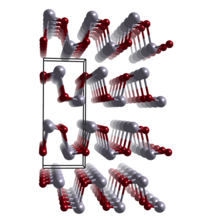
Back سيلينيد القصدير Arabic سلنید تنهکه AZB Zinn(II)-selenid German Seleniuro de estaño Spanish سلنید قلع Persian Séléniure d'étain French Ón-szelenid Hungarian Селенид олова Russian Kalaj(II) selenid Serbo-Croatian Kalaj(II) selenid Serbian

| |
| Names | |
|---|---|
| Other names
Tin(II) selenide
| |
| Identifiers | |
3D model (JSmol)
|
|
| ChemSpider | |
| ECHA InfoCard | 100.013.871 |
| EC Number |
|
PubChem CID
|
|
| UNII | |
| |
| |
| Properties | |
| SnSe | |
| Molar mass | 197.67 g/mol |
| Appearance | steel gray odorless powder |
| Density | 5.75 g/cm3[1] |
| Melting point | 861 °C (1,582 °F; 1,134 K) |
| negligible | |
| Band gap | 0.9 eV (indirect), 1.3 eV (direct)[2] |
| Structure | |
| Orthorhombic, oP8[2] | |
| Pnma, No. 62[2] | |
a = 4.4 Å, b = 4.2 Å, c = 11.5 Å[3]
| |
| Thermochemistry | |
Std enthalpy of
formation (ΔfH⦵298) |
-88.7 kJ/mol |
| Hazards | |
| GHS labelling: | |
  
| |
| Danger | |
| H301, H331, H373, H410 | |
| P260, P261, P264, P270, P271, P273, P301+P310, P304+P340, P311, P314, P321, P330, P391, P403+P233, P405, P501 | |
| NFPA 704 (fire diamond) | |
| Safety data sheet (SDS) | https://www.ltschem.com/msds/SnSe.pdf |
| Related compounds | |
Other anions
|
Tin(II) oxide Tin(II) sulfide Tin telluride |
Other cations
|
Carbon monoselenide Silicon monoselenide Germanium selenide Lead selenide |
Except where otherwise noted, data are given for materials in their standard state (at 25 °C [77 °F], 100 kPa).
| |
Tin selenide, also known as stannous selenide, is an inorganic compound with the formula SnSe. Tin(II) selenide is a typical layered metal chalcogenide[4] as it includes a group 16 anion (Se2−) and an electropositive element (Sn2+), and is arranged in a layered structure. Tin(II) selenide is a narrow band-gap (IV-VI) semiconductor structurally analogous to black phosphorus. It has received considerable interest for applications including low-cost photovoltaics, and memory-switching devices.
Because of its low thermal conductivity as well as reasonable electrical conductivity, tin selenide is one of the most efficient thermoelectric materials.[5][6]
- ^ https://www.rsc.org/suppdata/c7/ra/c7ra05819e/c7ra05819e1.pdf
- ^ a b c Cite error: The named reference
wirewas invoked but never defined (see the help page). - ^ Persson, Kristin (2014). "Materials Data on SnSe (SG:62) by Materials Project". LBNL Materials Project; Lawrence Berkeley National Laboratory (LBNL), Berkeley, CA (United States). doi:10.17188/1284598. Retrieved 2020-08-07.
- ^ Zhang, Chunli; Yin, Huanhuan; Han, Min; Dai, Zhihui; Pang, Huan; Zheng, Yulin; Lan, Ya-Qian; Bao, Jianchun; Zhu, Jianmin (2014). "Two-Dimensional Tin Selenide Nanostructures for Flexible All-Solid-State Supercapacitors". ACS Nano. 8 (4): 3761–70. doi:10.1021/nn5004315. PMID 24601530.
- ^ Zhao, L. D.; Lo, S. H.; Zhang, Y; Sun, H; Tan, G; Uher, C; Wolverton, C; Dravid, V. P.; Kanatzidis, M. G. (2014). "Ultralow thermal conductivity and high thermoelectric figure of merit in SnSe crystals". Nature. 508 (7496): 373–7. Bibcode:2014Natur.508..373Z. doi:10.1038/nature13184. PMID 24740068. S2CID 205238132.
- ^ Kang, Joon Sang; Wu, Huan; Li, Man; Hu, Yongjie (2019). "Intrinsic Low Thermal Conductivity and Phonon Renormalization Due to Strong Anharmonicity of Single-Crystal Tin Selenide". Nano Letters. 19 (8): 4941–4948. Bibcode:2019NanoL..19.4941K. doi:10.1021/acs.nanolett.9b01056. PMID 31265307. S2CID 206750455.
© MMXXIII Rich X Search. We shall prevail. All rights reserved. Rich X Search
